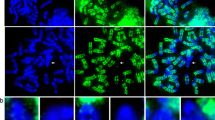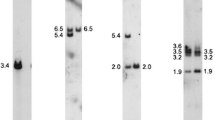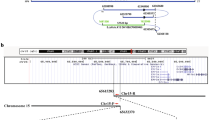Abstract
The nucleotide sequence of the human cDNA encoding ubiquitin-activating enzyme E1 is more than 99% identical with the human A1S9T cDNA, a gene that has been shown to complement the temperature-sensitive mutant mouse cell line, tsA1S9. The amino acid sequences of the proteins encoded by these two cDNA sequences are identical, and both cDNAs were previously shown to be located in the same region of the human X chromosome; thus, ubiquitin-activating enzyme E1 and A1S9T appear to be the same gene, designated UBE1. By in situ hybridization to metaphase chromosomes from male mice and by Southern blot analysis of male and female mouse DNA, we show that, in the mouse, a human UBE1 cDNA probe identified both X- and Y-linked loci. Ube1 is located at band A2 of the mouse X Chromosome (Chr) and Ube2 on the short arm of the Y Chr. This is in contrast to the situation in the human, where there is no evidence for Y-linked sequences related to UBE1. Mapping of the Ube1 gene in interspecific backcrosses between Mus spretus and C57BL/6 shows that the Ube1 locus maps close to Timp, in a conserved region of the mouse and human X Chrs that include Otc, Cybb, Syn1, Timp, and Araf. Expression of Ube1 on the inactive X Chr was examined to determine whether this gene is subject to X-Chr inactivation in the mouse, as there is previous evidence that the human UBE1 gene escapes, at least partially, X inactivation. Sequencing of reverse transcriptase polymerase chain reaction (RT-PCR) products from M. spretus, C57BL/6J, and T(X;16)16H x M. spretus F1 female mice indicates that the mouse Ube1 gene is subject to X-Chr inactivation in vivo. This represents a new example of differences between the sex chromosomes of mouse and human.
Similar content being viewed by others
References
Adler, D.A., Bressler, S.L., Chapman, V.M., Page, D.C., and Disteche, C.M.: Inactivation of the Zfx gene on the mouse X chromosome. Proc Natl Acad Sci USA 88: 4592–4595, 1991.
Ashworth, A., Skene, B., Swift, S., and Lovell-Badge, R.: Zfa is an expressed retroposon derived from an alternative transcript of the Zfx gene. EMBO J 9: 1529–1534, 1990.
Ashworth, A., Rastan, S., Lovell-Badge, R., and Kay, G.: X-chromosome inactivation may explain the difference in viability of XO humans and mice. Nature 351: 406–408, 1991.
Brown, C.J. and Willard, H.F.: Noninactivation of a selectable human X-linked gene that complements a murine temperature-sensitive cell cycle defect. Am J Hum Genet 45: 592–598, 1989.
Brown, C.J. and Willard, H.F.: Localization of a gene that escapes inactivation to the X chromosome proximal short arm: implications for X inactivation. Am J Hum Genet 46: 273–279, 1990.
Brown, C.J., Powers, V.E., Munroe, D.L., Sheinin, R., and Willard, H.F.: Gene on short arm of human X chromosome complements murine tsA1S9 DNA synthesis mutation. Somatic Cell Mol Genet 15: 173–178, 1989.
Chapman, V.M., Keitz, B.T., Disteche, C.M., and Lau, E.: Linkage of amelogenin (Amel) to the distal portion of the mouse X chromosome. Genomics 10: 23–28, 1991.
Chomczynski, P. and Sacchi, N. Single-step method of RNA isolation by acid guanidinium thiocyanate-phenol-chloroform extraction. Anal Biochem 162: 156–159, 1987.
Ciechanover, A., Finley, D., and Varshavsky, A.: The ubiquitinmediated proteolytic pathway and mechanisms of energy-dependent intracellular protein degradation. J Cell Biochem 24: 27–53, 1984.
Devereux, J., Haeberli, P., and Smithies, O.: A comprehensive set of sequence analysis programs for the VAX. Nucleic Acids Res 12: 387–395, 1984.
Feinberg, A.P. and Vogelstein, B.: A technique for radiolabeling DNA restriction endonuclease fragments to high specific activity. Anal Biochem 132: 6–13, 1983.
Fincham, A.G., Bessem, C.C., Lau, E.C., Pavlova, Z., Shuler, C., Slavkin, H.C., and Snead, M.L.: Human developing enamel proteins exhibit a sex-linked dimorphism. Calcif Tissue Int 48: 288–290, 1991.
Fisher, E.M., Beer-Romero, P., Brown, L.G., Ridley, A., McNeil, J.A., Lawrence, J.B., Willard, H.F., Bieber, F.R., and Page, D.C.: Homologous ribosomal protein genes on the human X and Y chromosomes: escape from X inactivation and possible implications for Turner syndrome. Cell 63: 1205–1218, 1990.
Haas, A.L. and Rose, I.A.: The mechanism of ubiquitin activating enzyme. A kinetic and equilibrium analysis. J Biol Chem 257: 10329–10337, 1982.
Haas, A.L., Warms, J.V., Hershko, A., and Rose, I.A.: Ubiquitin-activating enzyme. Mechanism and role in protein-ubiquitin conjugation. J Biol Chem 257: 2543–2548, 1982.
Handley, P.M., Mueckler, M., Siegel, N.R., Ciechanover, A., and Schwartz, A.L.: Molecular cloning, sequence, and tissue distribution of the human ubiquitin-activating enzyme E1. Proc Natl Acad Sci USA 88: 258–262, 1991.
Hatfield, P.M., Callis, J., and Vierstra, R.D.: Cloning of ubiquitin activating enzyme from wheat and expression of a functional protein in Escherichia coli. J Biol Chem 265: 15813–15817, 1990.
Hershko, A.: Ubiquitin: roles in protein modification and breakdown. Cell 34: 11–12, 1983.
Kawasaki, E.S., Clark, S.S., Coyne, M.Y., Smith, S.D., Champlin, R., Witte, O.N., and McCormick, F.P.: Diagnosis of chronic myeloid and acute lymphocytic leukemias by detection of leukemiaspecific mRNA sequences amplified in vitro. Proc Natl Acad Sci USA 85: 5698–5702, 1988.
Koopman, P., Gubbay, J., Collignon, J., and Lovell-Badge, R.: Zfy gene expression patterns are not compatible with a primary role in mouse sex determination. Nature 342: 940–942, 1989.
Kudo, M., Sugasawa, K., Hori, T., Enomoto, T., Hanaoka, F., and Ui, M.: Human ubiquitin-activating enzyme (E1): compensation for heat-labile mouse E1 and its gene localization on the X chromosome. Exp Cell Res 192: 110–117, 1991.
Lyon, M.F., Searle, A.G., Ford, C.E., and Ohno, S.: A mouse translocation suppressing sex-linked variegation. Cytogenetics 3: 306–323, 1964.
Mardon, G. and Page, D.C.: The sex determining region of the mouse Y chromosome encodes a protein with a highly acidic domain and 13 zinc fingers. Cell 56: 765–770, 1989.
Mardon, G., Luoh, S-W., Simpson, E.M., Gill, G., Brown, L.G., and Page, D.C.: Mouse Zfx protein is similar to Zfy-2: each contains an acidic activating domain and 13 zinc fingers. Mol Cell Biol 10: 681–688, 1990.
McGrath, J.P., Jentsch, S., and Varshavsky, A.: UBE1: an essential yeast gene encoding ubiquitin-activating enzyme. EMBO J 10: 227–236, 1991.
Mitchell, M.J. and Bishop, C.E.: Cloning of Sby, a candidate for Hya and Spy, from the Sxr region of the mouse Y chromosome. 8th International Congress of Human Genetics, Abstract 2343, 1991.
Mullins, L.J., Grant, S.G., Stephenson, D.A., and Chapman, V.M.: Multilocus molecular mapping of the mouse X chromosome. Genomics 3: 187–194, 1988.
Nagamine, C.M., Chan, K., Hake, L.E., and Lau, Y.F.: The two candidate testis-determining Y genes (Zfy-1 and Zfy-2) are differentially expressed in fetal and adult mouse tissues. Genes Dev 4: 63–74, 1990.
Nakahori, Y., Takenaka, O., and Nakagome, Y.: A human X-Y homologous region encodes “amelogenin.” Genomics 9: 264–269, 1991.
Palmer, M.S., Berta, P., Sinclair, A.H., Pym, B., and Goodfellow, P.N.: Comparison of human ZFY and ZFX transcripts. Proc Natl Acad Sci USA 87: 1681–1685, 1990.
Rechsteiner, M.: Natural substrates of the ubiquitin proteolytic pathway. Cell 66: 615–618, 1991.
Sambrook, J., Fritsch, E.F., and Maniatis, T.: Molecular Cloning: A Laboratory Manual, 2nd edition, Cold Spring Harbor Laboratory Press, New York, 1989.
Sanger, F.S., Nicklen, S., and Coulson, A.R.: DNA sequencing with chain-terminating inhibitors. Proc Natl Acad Sci USA 74: 5463–5467, 1977.
Schneider-Gädicke, A., Beer-Romero, P., Brown, L.G., Nussbaum, R., and Page, D.C.: ZFX has a gene structure similar to ZFY, the putative human sex determinant, and escapes X inactivation. Cell 57: 1247–1258, 1989.
Shapiro, L.J., Mohandas, T., and Weiss, R.: Non-inactivation of an X-chromosome locus in man. Science 204: 1224–1226, 1979.
Tedder, T.F., Klejman, G., Disteche, C.M., Adler, D.A., Schlossman, S.F., and Saito, H.: Cloning of a complementary DNA encoding a new mouse B lymphocyte differentiation antigen, homologous to the human B1 (CD20) antigen, and localization of the gene to chromosome 19. J Immunol 141: 4388–4394, 1988.
Zacksenhaus, E. and Sheinin, R.: Molecular cloning of human A1S9 locus: an X-linked gene essential for progression through S phase of the cell cycle. Somatic Cell Mol Genet 15: 545–553, 1989.
Zacksenhaus, E. and Sheinin, R.: Molecular cloning, primary structure and expression of the human X-linked A1S9 gene cDNA which complements the tsA1S9 mouse L cell defect in DNA replication. EMBO J 9: 2923–2929, 1990.
Zacksenhaus, E., Sheinin, R., and Wang, H.S.: Localization of the human A1S9 gene complementing the ts A1S9 mouse L-cell defect in DNA replication and cell cycle progression to Xp11.2–p11.4. Cytogenet Cell Genet 53: 20–22, 1990.
Zinn, A.R., Bressler, S.L., Beer-Romero, P., Adler, D.A., Chapman, V.M., Page, D.C., and Disteche, C.M.: Inactivation of the Rps4 gene on the mouse X chromosome. Genomics 11: 1097–1101, 1991.
Author information
Authors and Affiliations
Additional information
Offprint requests to: J.F. Gusella
Rights and permissions
About this article
Cite this article
Disteche, C.M., Zacksenhaus, E., Adler, D.A. et al. Mapping and expression of the ubiquitin-activating enzyme E1 (Ube1) gene in the mouse. Mammalian Genome 3, 156–161 (1992). https://doi.org/10.1007/BF00352460
Received:
Accepted:
Issue Date:
DOI: https://doi.org/10.1007/BF00352460




